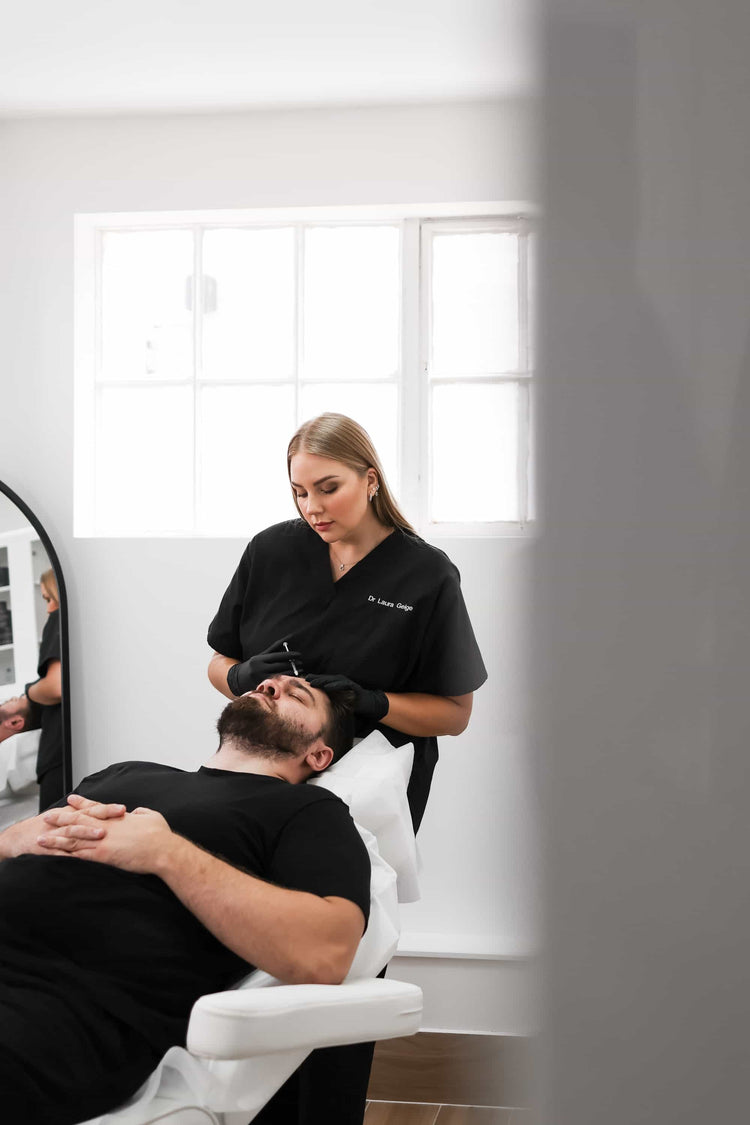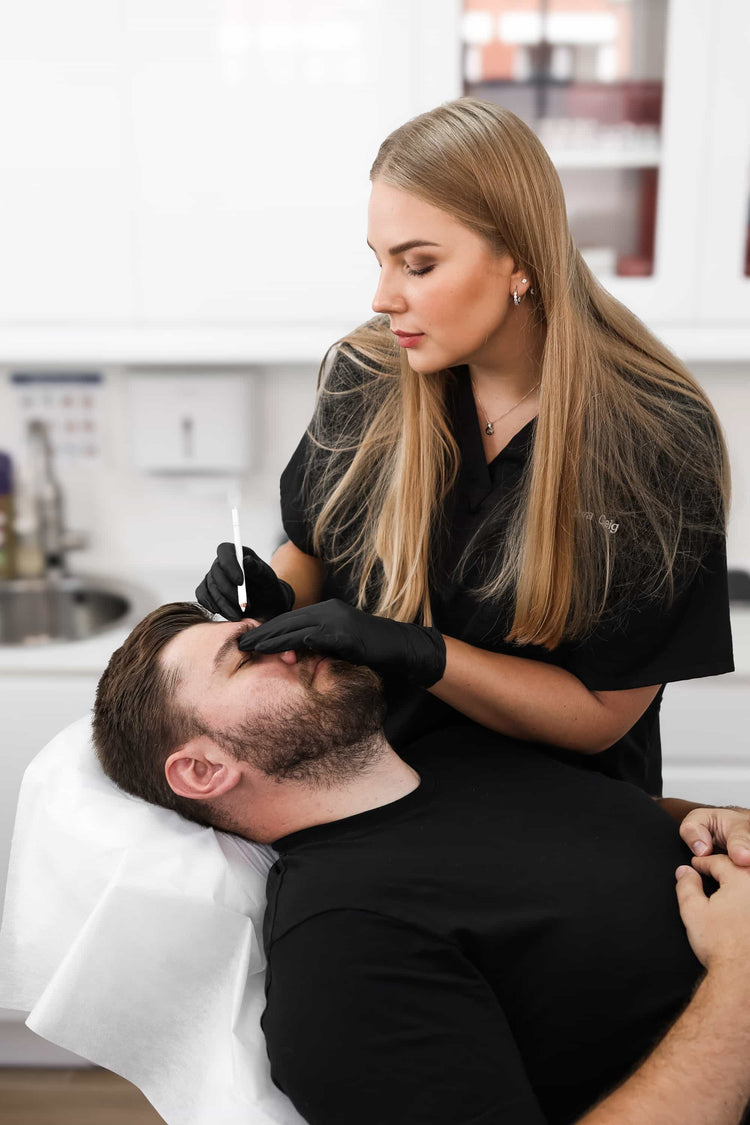Anti-Wrinkle Injections
As we age, wrinkles and fine lines become more prominent, leading many to seek ways to minimize their appearance. Anti-wrinkle injections have emerged as a popular non-surgical option for smoothing out facial creases and achieving a more youthful look in the UK.
Mechanism of Action
Anti-wrinkle injections work by temporarily blocking nerve signals that cause muscles to contract. This reduces the muscle activity responsible for wrinkle formation, leading to a smoother appearance.
- Botulinum toxin type A is the active ingredient in anti-wrinkle injections.
- It is injected directly into targeted facial muscles, such as those around the forehead, eyes, and mouth.
- The effects of anti-wrinkle injections typically last for several months, gradually wearing off over time.

Cost and Accessibility
Compared to other anti-aging treatments, anti-wrinkle injections offer a relatively quick, minimally invasive, and affordable solution. Surgical procedures like facelifts are more invasive and have longer recovery times, making them less accessible for some individuals. Chemical peels and microdermabrasion can improve skin texture and tone but may not be as effective in addressing deeper wrinkles.
The cost of anti-wrinkle injections varies depending on factors such as the number of areas treated, the practitioner’s experience, and the location of the clinic. However, it is generally considered more affordable than surgical procedures.
Accessibility of anti-wrinkle injections is generally high in the UK. Many clinics offer these treatments, and they are becoming increasingly commonplace. It is important to choose a qualified and experienced practitioner to ensure safe and effective treatment.
Results and Duration
Anti-wrinkle injections provide a temporary solution for reducing the appearance of wrinkles and fine lines. They work by relaxing the muscles responsible for facial expressions that contribute to wrinkle formation.
Results typically become visible within a few days, with full effects achieved after about two weeks. The smoothing effect lasts for several months, often between three to six, before gradually fading away.
The duration of results may vary depending on individual factors such as muscle activity, metabolism, and the dosage of the injection. Multiple treatments are generally required to maintain the desired outcome.
Dermal Fillers
In the quest for a youthful appearance, dermal fillers have gained significant traction in the UK. These injectables offer a non-surgical approach to restoring volume and smoothing wrinkles. Dermal fillers typically consist of hyaluronic acid, a natural substance found in the body that attracts and retains moisture.
Types of Fillers
Dermal fillers come in various types, each designed for specific aesthetic goals.
Hyaluronic acid-based fillers are the most common type, used to plump up lips, smooth wrinkles around the mouth and nose, and add volume to cheeks or jawline.
Calcium hydroxylapatite (CaHA) is another option, often chosen for its ability to stimulate collagen production, resulting in a more natural-looking lift.
Poly-L-lactic acid (PLLA) fillers are designed to gradually stimulate collagen growth over time, providing longer-lasting results for volume restoration.
Areas of Application
Dermal fillers are injected beneath the skin to add volume and smooth out wrinkles. They are commonly used to address various areas of concern, including lips, cheeks, smile lines (nasolabial folds), marionette lines (lines extending from the corners of the mouth), and under-eye hollows.
Lip augmentation is a popular application of dermal fillers. Fillers can increase lip size, enhance shape, and define the Cupid’s bow, giving a fuller and more youthful appearance.
Dermal fillers are also effective in restoring volume to cheeks, creating a more lifted and sculpted look. This can counteract age-related volume loss that contributes to sagging or flattening of the face.
Smile lines and marionette lines, which are wrinkles that run from the nose to the corners of the mouth and from the corners of the mouth downwards, respectively, can be smoothed out with dermal fillers.
Under-eye hollows, which often appear as dark circles or sunken areas beneath the eyes, can also be treated with dermal fillers. By adding volume, they can help diminish the appearance of these hollows and create a more youthful and refreshed look.
Pros and Cons Compared to Anti-Wrinkle Injections
Dermal fillers and anti-wrinkle injections are both popular non-surgical treatments for reducing signs of aging. Both offer benefits, but they work in different ways and address specific concerns.
Dermal fillers add volume to the skin, smoothing out wrinkles and restoring lost fullness. Anti-wrinkle injections work by relaxing muscles that cause wrinkles, preventing them from forming or deepening.
Here’s a comparison of the pros and cons of each treatment:
Dermal Fillers:
- Pros: Immediate results, long-lasting effects (sometimes up to two years), can add volume and plumpness, treat various concerns like lips, cheeks, wrinkles.
- Cons: Can be more expensive than anti-wrinkle injections, may cause bruising or swelling after treatment, requires multiple treatments for optimal results, potential for complications like lumps or migration of the filler.
Anti-Wrinkle Injections:
- Pros: Relatively quick and easy procedure, less downtime than fillers, affordable compared to surgery, noticeable results within days.
- Cons: Temporary results (lasting 3-6 months), may not be effective for deeper wrinkles, potential for bruising or swelling, muscle weakness can occur if the injections are done incorrectly.
Ultimately, the best choice for you will depend on your individual needs and goals. Consulting with a qualified medical professional is essential to determine the most suitable treatment option for your specific concerns.
Laser Treatments
In the pursuit of youthful radiance, various anti-aging treatments have emerged, each offering unique benefits and approaches. While surgical interventions like facelifts provide dramatic results, they come with significant downtime and potential risks.
Different Types of Lasers
Laser treatments have become increasingly popular for addressing a range of skin concerns, from wrinkles to pigmentation issues. These treatments utilize concentrated beams of light energy to target specific areas of the skin.
Different types of lasers are used depending on the desired outcome.
Ablative lasers, such as CO2 lasers, remove the top layer of skin, promoting collagen production and revealing smoother, younger-looking skin.
Non-ablative lasers, like fractional lasers and Nd:YAG lasers, target deeper layers of the skin without causing significant surface damage. They stimulate collagen growth and can reduce the appearance of wrinkles, fine lines, and scars.
IPL (Intense Pulsed Light) is a non-laser technology that uses broad spectrum light to target pigmented lesions, redness, and vascular concerns like spider veins.
Suitable Skin Concerns
Laser treatments offer a versatile approach to skin rejuvenation, addressing various concerns with targeted light energy.
- Wrinkles and Fine Lines: Lasers stimulate collagen production, smoothing wrinkles and improving skin texture.
- Pigmentation Issues: Certain lasers can break down melanin pigment, reducing the appearance of age spots, sunspots, and hyperpigmentation.
- Vascular Lesions: IPL or specific laser wavelengths target blood vessels, minimizing the appearance of spider veins and redness.
- Scar Revision: Lasers can help improve the appearance of acne scars and other types of scars by stimulating collagen and promoting skin remodeling.
Recovery Time and Downtime
Laser treatments offer a range of benefits for addressing various skin concerns. Recovery time and downtime vary depending on the type of laser used and the extent of the treatment.
Ablative lasers, which remove the top layer of skin, typically require longer downtime, with patients experiencing redness, swelling, and scabbing for several days to weeks.
Non-ablative lasers generally have shorter downtime, with minimal discomfort and redness that usually subsides within a few days.
It is important to follow your practitioner’s instructions for post-treatment care to ensure optimal healing and minimize the risk of complications. This may include protecting the skin from sun exposure, using prescribed medications, and avoiding certain activities.
Chemical Peels
Chemical peels involve applying a chemical solution to the skin to remove the top layer, revealing smoother, younger-looking skin underneath. There are various types of chemical peels, ranging in strength from mild to deep, each addressing specific skin concerns.
Types of Chemical Peels
Chemical peels utilize a chemical solution to exfoliate the skin’s surface, promoting cell turnover and revealing smoother, more radiant skin.
They are categorized into different types based on their depth of penetration and the strength of the chemicals used:
- Superficial Peels: These peels use mild acids like alpha-hydroxy acids (AHAs) or beta-hydroxy acids (BHAs). They primarily address superficial skin concerns such as fine lines, uneven skin tone, and acne. Superficial peels have minimal downtime and are suitable for most skin types.
- Medium Peels: These peels utilize slightly stronger acids like trichloroacetic acid (TCA) to penetrate deeper into the skin. They can effectively reduce moderate wrinkles, pigmentation issues, and sun damage. Medium peels typically involve a few days of downtime with redness and peeling.
- Deep Peels: The most aggressive type of peel, deep peels employ strong acids like phenol. They target deeper wrinkles, severe acne scarring, and other significant skin imperfections. Deep peels require significant downtime (several weeks) with potential for complications if not performed properly.
Chemical peels can be a valuable tool for improving the appearance of various skin concerns. It is crucial to consult with a qualified dermatologist or aesthetic practitioner to determine the most appropriate type of peel based on your individual needs and skin condition.
Skin Rejuvenation Benefits
Chemical peels are a popular skin rejuvenation treatment that involves applying a chemical solution to exfoliate the top layers of skin. This process helps reveal smoother, brighter skin beneath. There are different types of chemical peels, ranging in strength from superficial to deep. Superficial peels are often used to address mild issues like fine lines, uneven skin tone, and acne. They involve minimal downtime and can be performed more frequently.

Medium peels use stronger acids and target deeper concerns such as wrinkles, pigmentation, and sun damage. They require a bit more downtime for healing. Deep peels are the strongest type and address severe skin imperfections like deep wrinkles, acne scars, and uneven skin texture. However, they come with a longer recovery period and potential risks.
Chemical peels can be an effective way to improve the appearance of your skin, but it’s important to consult with a qualified dermatologist or aesthetic practitioner to determine which type of peel is best suited for your individual needs and skin type. They will assess your skin condition and discuss potential benefits, risks, and downtime involved.
Potential Side Effects
Chemical peels offer a way to improve skin tone and texture by exfoliating the top layers of skin. Potential side effects can vary depending on the type of peel performed and individual sensitivity. Common side effects may include redness, peeling, itching, and dryness.
In some cases, more severe reactions like infection, scarring, or changes in skin pigmentation may occur. It’s crucial to choose a qualified and experienced practitioner to minimize the risk of complications.
Topical Anti-Aging Products
Topical anti-aging products are designed to address signs of aging on the skin’s surface. They often contain ingredients that aim to hydrate, protect, and improve the appearance of fine lines, wrinkles, age spots, and uneven skin tone.
Active Ingredients to Look For
When selecting topical anti-aging products, look for active ingredients backed by scientific research.
Here are some key ingredients to consider:
- Retinoids: Derived from vitamin A, retinoids like retinol and tretinoin increase cell turnover, reduce fine lines and wrinkles, and improve skin texture.
- Vitamin C: A potent antioxidant, vitamin C protects against free radical damage, brightens skin tone, and stimulates collagen production.
- Hyaluronic Acid: This humectant attracts and retains moisture, plumping up the skin and reducing the appearance of fine lines.
- Peptides: These short chains of amino acids can stimulate collagen production, improve skin elasticity, and reduce the appearance of wrinkles.
- Alpha-Hydroxy Acids (AHAs): Like glycolic acid and lactic acid, AHAs exfoliate the skin, revealing smoother, brighter skin and reducing hyperpigmentation.
- Niacinamide: Also known as vitamin B3, niacinamide has anti-inflammatory properties, minimizes pores, improves skin barrier function, and reduces redness.
Remember that consistency is key when using topical anti-aging products. It takes time to see noticeable results. Start with a gentle product and gradually increase the strength or frequency of application as your skin adjusts.
Effectiveness Compared to Other Treatments
Topical anti-aging products offer a convenient way to address early signs of aging, but their effectiveness in treating deeper wrinkles or restoring volume is limited compared to procedures like anti-wrinkle injections or dermal fillers.
These products primarily work on the skin’s surface by hydrating, protecting, and exfoliating to improve texture and tone. While ingredients like retinol can stimulate collagen production, their effects are generally milder and more gradual than injectable treatments.
Topical anti-aging products can be a valuable addition to a skincare routine for maintaining youthful radiance, but they should not be solely relied upon for significant wrinkle reduction or volume restoration.
Maintenance and Long-Term Results
Anti-wrinkle injections and dermal fillers are two popular non-surgical approaches to addressing signs of aging in the UK. Both treatments offer distinct benefits and target specific concerns.
Anti-wrinkle injections, commonly known as Botox, work by temporarily paralyzing muscles that cause wrinkles. This smoothing effect lasts for several months and is ideal for minimizing dynamic wrinkles—lines that appear when you smile, frown, or squint.
Dermal fillers, on the other hand, add volume to specific areas of the face, plumping up wrinkles, enhancing lips, and restoring lost fullness in cheeks or jawline. Fillers typically contain hyaluronic acid, a substance naturally found in the body that attracts and retains moisture.
The best choice for you depends on your individual goals and concerns.
Anti-wrinkle injections are suitable for those seeking to reduce dynamic wrinkles and prevent further wrinkle formation. Dermal fillers are more effective at addressing static wrinkles—lines that are present even when the face is at rest, as well as adding volume and shaping facial contours.
Many people combine both treatments for a comprehensive approach to anti-aging, achieving smoother skin and a more youthful appearance.
Consulting with a qualified medical practitioner experienced in both anti-wrinkle injections and dermal fillers is essential. They can assess your needs, discuss the potential benefits and risks, and recommend the most appropriate treatment plan for you.
Enquire about non-surgical wrinkle treatments at It’s Me & You Clinic with Dr. Laura Geige
- What Is Relationship Anarchy And Why Is It Gaining Popularity? - November 3, 2025
- Weed Drinks That Help With Sleep - October 31, 2025
- Under Eye Filler For Eye Bags In West Molesey, Surrey - October 28, 2025
